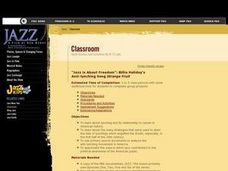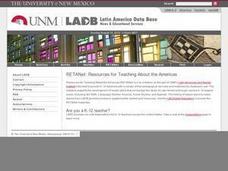Curated OER
Famous Black Americans
Students recognize famous Black Americans and their roles in America's society. They create a database and slideshow presenting famous Black Americans and relevant facts of their lives.
Curated OER
Prudence Crandall House and Little Rock High School
Students examine how Prudence Crandall influenced the education of African Americans in New England prior to the Civil War and compare and contrast events in Canterbury, CN in the 1830's to those in Little Rock, AR in the 1950's.
Curated OER
Life in the Colonies
What was life like for the early colonists? Read along with an informational presentation, rich in text. Colonial slavery, slave culuture, colonial religion, and the Great Awakening are all described in full. Tip: The resource could be...
Curated OER
Slavery of Africans in the Americas: Resistance to Enslavement
Students explore the many ways African and African-American slaves resisted their enslavement in the Americas with special emphasis on the slave songs and maroon societies of slaves.
Curated OER
African Masks (Pre-Visit)
Second graders observe and describe several masks from different parts of Africa housed in the Smithsonian Institute (National Museum of African Art) Washington, D.C. They use the internet to view the Smithsonian's virtual exhibits.
Curated OER
Differences in Location Lesson Plan: Treatment of Early African Americans
Students reach The Domestic Slave Trade, then examine the differences between the people enslaved in North America as opposed to those in Brazil.
Curated OER
Boombox Classroom: Native American
For this music worksheet, students circle names of Native American tribes or nations. They answer three true/false questions. Students answer 3 multiple choice question about the history of Native America. They name 8 music notations.
Curated OER
Breaking the Color Barrier: Jackie Robinson's Combat Against Racism
Students explore Jackie Robinson's career. In this 20th century American history lesson, students complete the provided analysis questions based on the provided primary documents about Jackie Robinson. Students discuss Jackie' Robinson's...
Curated OER
Mrs. Katz and Tush
Students read Patricia Polacco's Mrs. Katz and Tush before comparing Jewish heritage with Black history using a Venn Diagram. They complete the diagram either as a whole group or in a small group setting. Next, they sample the Jewish...
Curated OER
Changing Attitudes in America
Students discuss strategies for confronting destructive stereotypes and mythologies, as well as promoting racial understanding in Students.
Curated OER
The Motown Dynasty (1969-1980) Part 2
Students connect achievements of noted artists with their roles in the music industry. They identify many Black music industry leaders and their contributions with the Motown Sound.
Curated OER
Rhythm Sticks
Music and dance appreciation are important to the education of children to help them appreciate the cultures that make up our society. Rhythm sticks teach kids artistic perception of rhythm in music and how to move their bodies and tap...
Curated OER
Africa: Journey To a Wildlife Park
Students identify similarities and differences between Rehema's life and culture, and their own.
Curated OER
Island Research
Students collaborate to gather information about the geography, history, economy, climate, culture, and other aspects of life on the island of Eleuthera.
Curated OER
Torn from Each Other's Arms
Students consider how the institution of family suffered under slavery. For this slavery lesson, students watch segments of "Slavery and the Making of America". Students examine the structure of the Driggus family and discuss how slavery...
Curated OER
Migration and Immigration in the United States: Three Case Studies
Students examine the early migration of Native Americans, African Americans, and the British Colonists. They conduct Internet research, complete a timeline, label maps, compare/contrast the three groups' experiences, and write an essay.
Curated OER
Immigration: A History
Studnets trace how immigration patterns have changed in America's history. They analyze the relationship between economic growth and immigration.
Curated OER
"Jazz is About Collaboration": Jim Crow Laws And Segregation
Students explore development of jazz music in the 1930s by forming imaginary jazz bands which tour several cities in Depression-era America. Jazz band members create imaginary identities for themselves, develop publicity for their tour,...
Curated OER
An Analysis of Jim Crow Laws and their Effects on Race Relations
First graders analyze the role of the Jim Crow laws on race relations. As a class, they are segregated based on the color shirt they have or some other simple criteria and wear either a square or circle sticker representing the majority...
Curated OER
"Jazz is About Freedom": Billie Holiday's Anti-lynching Song Strange Fruit
Working in small teams, learners analyze a variety of primary source materials related to lynching (news articles, letters written to or written by prominent Americans, pamphlets, broadsides, etc.) in order to assess the effectiveness of...
Curated OER
Africa
Second graders explore Africa. They label the popular places in Africa on a map. Students label the different cities and monuments that are popular in Africa. They discuss the similarities and differences between cities in Africa and...
Curated OER
History of the American Family
Students discover the history of the American family and the affects of immigration. In addition, they examine the contributions of minority families to American culture. In groups, students explore the pros and cons of dual-income...
Curated OER
Gotta Be Me
Students create model societies. In this social identity lesson, students conduct research so that they can plan and present model societies to their classmates. The societies must include information regarding how their society will...
Curated OER
Different Ethnic Groups in Ecuador, Panama and Argentina: Their Assimilation and their Contributions
Students research various Latin American countries and reflect on the different ethnic communities represented in that country and their contributions to the region. They make posters, perform skits and write letters about their research.

























